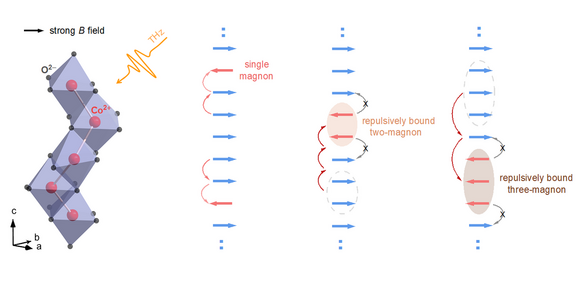Exotic quantum state observed

Atoms, molecules or solids that are formed by attractive forces between their components are ubiquitous in nature. In contrast to these well-known stable composite objects, those stabilized by repulsive forces were long considered theoretical constructs due to their instability in naturally occurring systems. Especially in solid-state compounds, the observation of repulsively bound particles was considered impossible. Recently, an international team of researchers led by Prof. Zhe Wang succeeded in experimentally observing repulsively bound magnons - an exotic quantum many-body state.
The observation was made in the special spin-chain compound BaCo2V2O8; spins are an intrinsic magnetic degree of freedom of the electrons in an atom. In BaCo2V2O8, the team used terahertz light waves to excite the spins and study their dynamics in strong external magnetic fields of up to 60 Tesla. On the one hand, the researchers identified the already known magnons, i.e. low-energy magnetic elementary quasiparticle excitations. On the other hand, they also discovered the special repulsively bound two-magnon and three-magnon states as high-energy composite excitations. The BaCo2V2O8 compound is a solid-state realization of the Heisenberg-Ising model, which has been important for understanding many physical phenomena for over a hundred years. The model has already influenced various branches of physics - from condensed matter to cold atoms and quantum information.
"The observation of repulsively bound magnons was surprising for us," says Prof. Zhe Wang. "Our study provides a first understanding of these complex quantum many-body states in a representative solid-state system. How these exotic states manifest themselves in other, even more complex quantum systems and also their potential applications in quantum information are very exciting and challenging tasks for future research."

